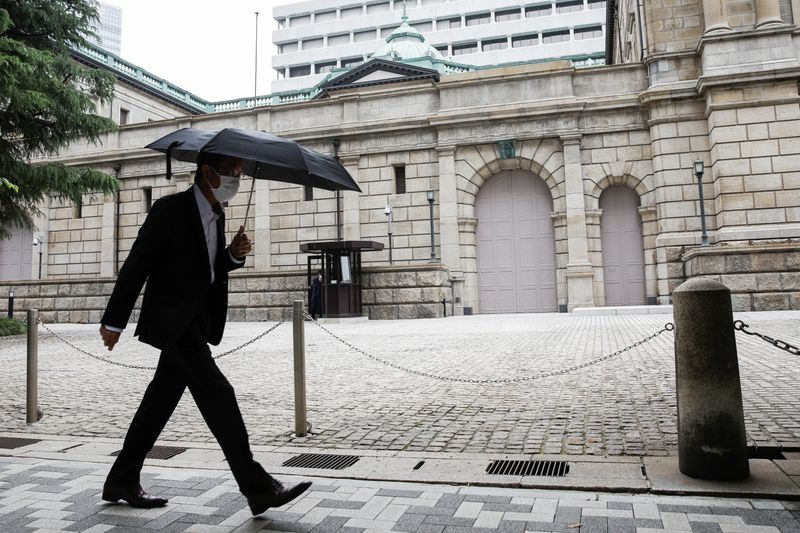Analysis: With new bank aid, BOJ makes stealthy retreat from negative rates

By Leika Kihara
TOKYO (Reuters) – The Bank of Japan is quietly walking back its unpopular negative interest rates policy with a controversial scheme designed to drive mergers among weaker, smaller lenders, a move some insiders see as a risky deviation into industrial reform.
As COVID-19 adds pain for regional banks suffering from years of ultra-low interest rates, the BOJ this month unveiled a plan to pay 0.1% interest on deposits held by lenders that cut costs, boost profits or consolidate.
The programme means the BOJ will for the first time offer payouts to a specific industry with the aim of driving reform in that sector. Critics warn such policy should be directed by elected officials, not central bankers.
“The BOJ is incentivising unviable banks to merge before they end up going under,” said Tomoyuki Shimoda, a former BOJ official who is now professor at Hitotsubashi University. “It’s a pretty bold decision. There’s no turning back.”
Some BOJ executives were against the scheme, which defied the central bank’s tradition of being “a lender not a spender,” according to three sources with direct knowledge of the matter.
But after more than a year of groundwork by BOJ bureaucrats and bank regulators, the plan went through, the sources said, a sign that regional banks were in worse shape than BOJ Governor Haruhiko Kuroda was willing to admit.
“It’s a message to regional banks that time is running short,” one of the sources said. “Were it not for the seriousness of the problem, the BOJ wouldn’t have gone this far,” another source said, a view echoed by a third source.
The BOJ declined to comment for the story.
UNCHARTED TERRITORY
The decision highlights how Kuroda’s defense of his stimulus policies – and his view the cost of prolonged easing is manageable – is crumbling, forcing him to pay the price for his radical measures with an even more controversial programme.
It also marked another retreat from negative rates, a policy long criticised by banks as crushing yields across the curve and narrowing already thin margins, two other sources said.
The policy was unpopular from the outset. Just eight months after its launch in 2016, the BOJ was forced to set a target for 10-year bond yields to avoid excessive falls in long-term rates.
It also shrank the pool of funds to which negative rates were applied to around 5 trillion yen ($48 billion) – or 1% of total reserves financial institutions park with the BOJ.
“The aid scheme is part of the BOJ’s attempt to phase out the impact of negative rates, which has been going on over the past few years,” said former BOJ executive Hideo Hayakawa, who retains close contact with incumbent policymakers.
“The BOJ can’t openly concede the policy was a failure or ditch it altogether, so it’s quietly dialing it back,” he said.
Of nearly 70 trillion yen in reserves, around 50 trillion yen could be targeted for the 0.1% interest for up to three years, according to Dai-ichi Life Research Institute.
Short-term rates may creep up if the banks tap markets for funds that they then shift to BOJ deposits to earn 0.1% interest. That would complicate the BOJ’s efforts to meet its -0.1% short-term rate target and cast doubt on Kuroda’s argument the scheme won’t affect monetary policy, some analysts say.
The fact the BOJ crossed the line to forestall a banking crisis highlights a deepening concern among policymakers over the rising cost of prolonged easing.
Combined net profits at Japan’s 102 regional banks have tumbled 40% over the past four years as lending margins sank to 0.2%.
A recent stress test by the BOJ showed in the most severe economic downturn scenario, their average capital-to-asset ratio would slide to 7% in fiscal 2022 from the current 10% and a few points above the required 4%.
Several BOJ board members have publicly warned an increase in pandemic-driven bankruptcies could saddle banks with bad loans and threaten Japan’s financial system.
“It has become extremely important to pay more attention to the side-effects of prolonged easing,” board member Takako Masai said, signalling that the BOJ should focus on making its policy framework sustainable rather than deploy further stimulus.
The growing alarm within the board over the demerits of his stimulus programme may make it harder for Kuroda to ease further, especially by deepening negative rates.
“If banking-sector problems are as serious as the BOJ suggests, deepening negative rates would make matters worse,” said a fourth source familiar with the BOJ’s thinking. “It’s quite clear the BOJ wants to avoid deepening negative rates.”

